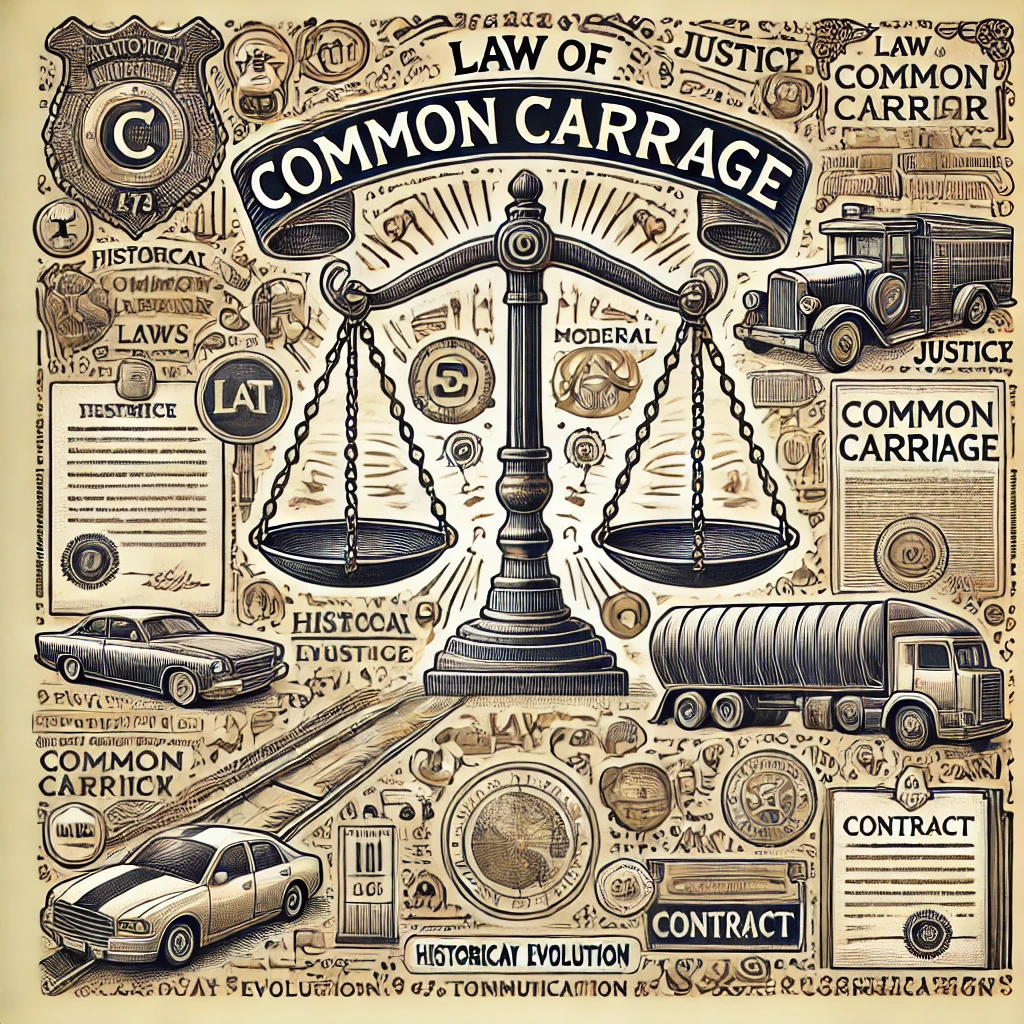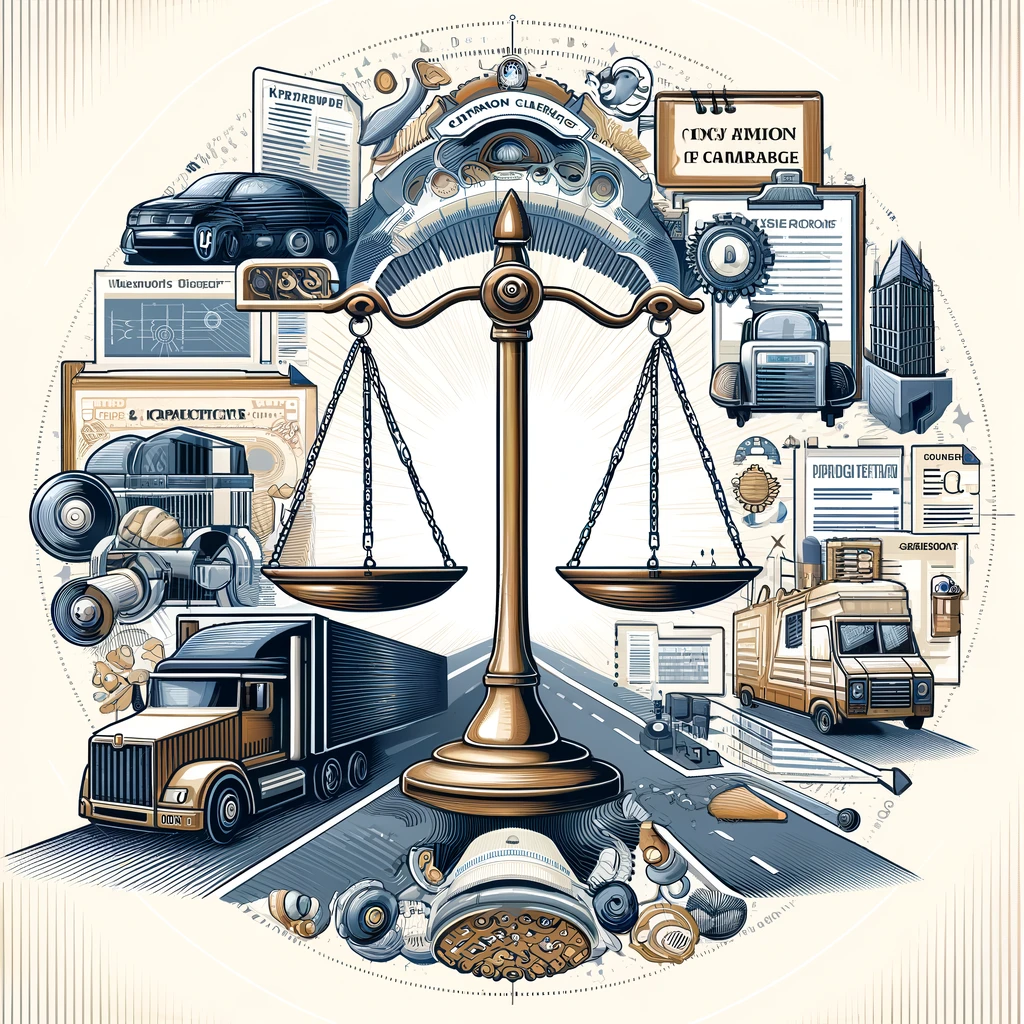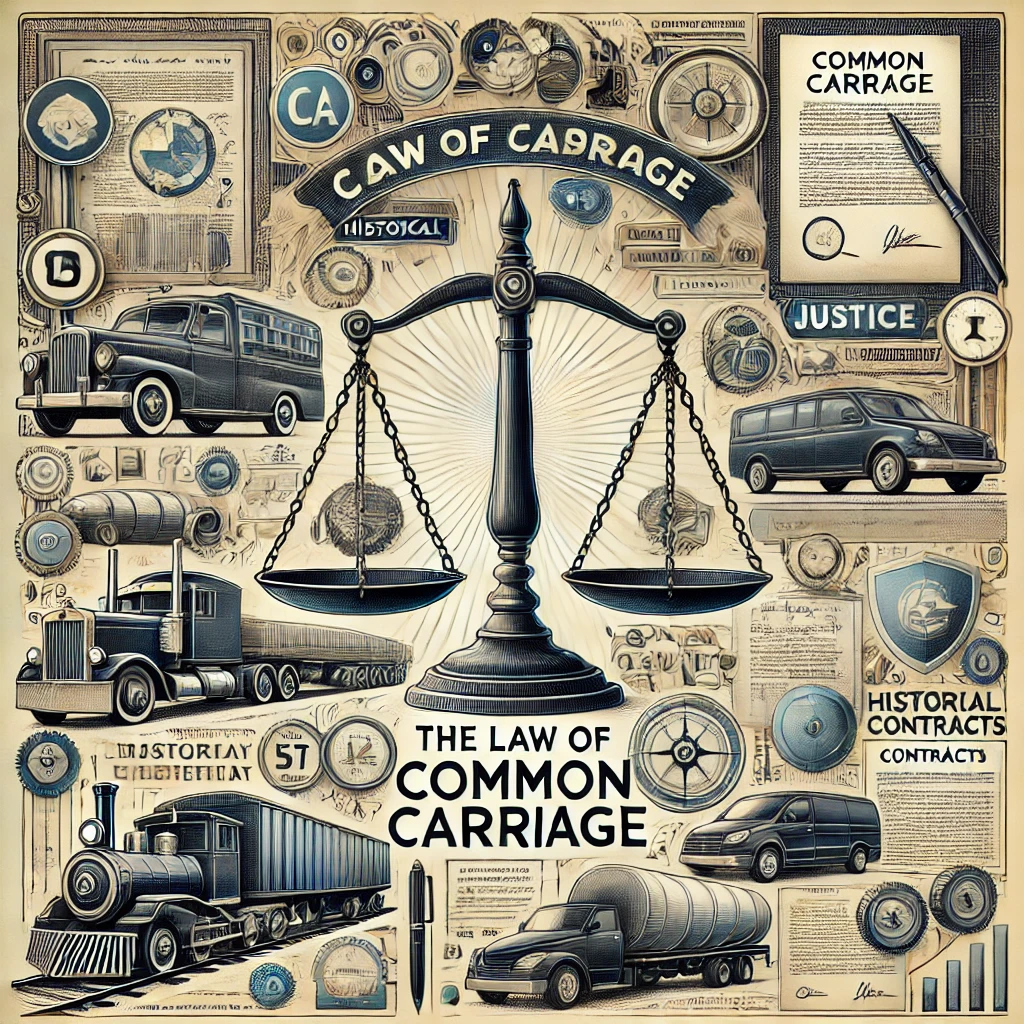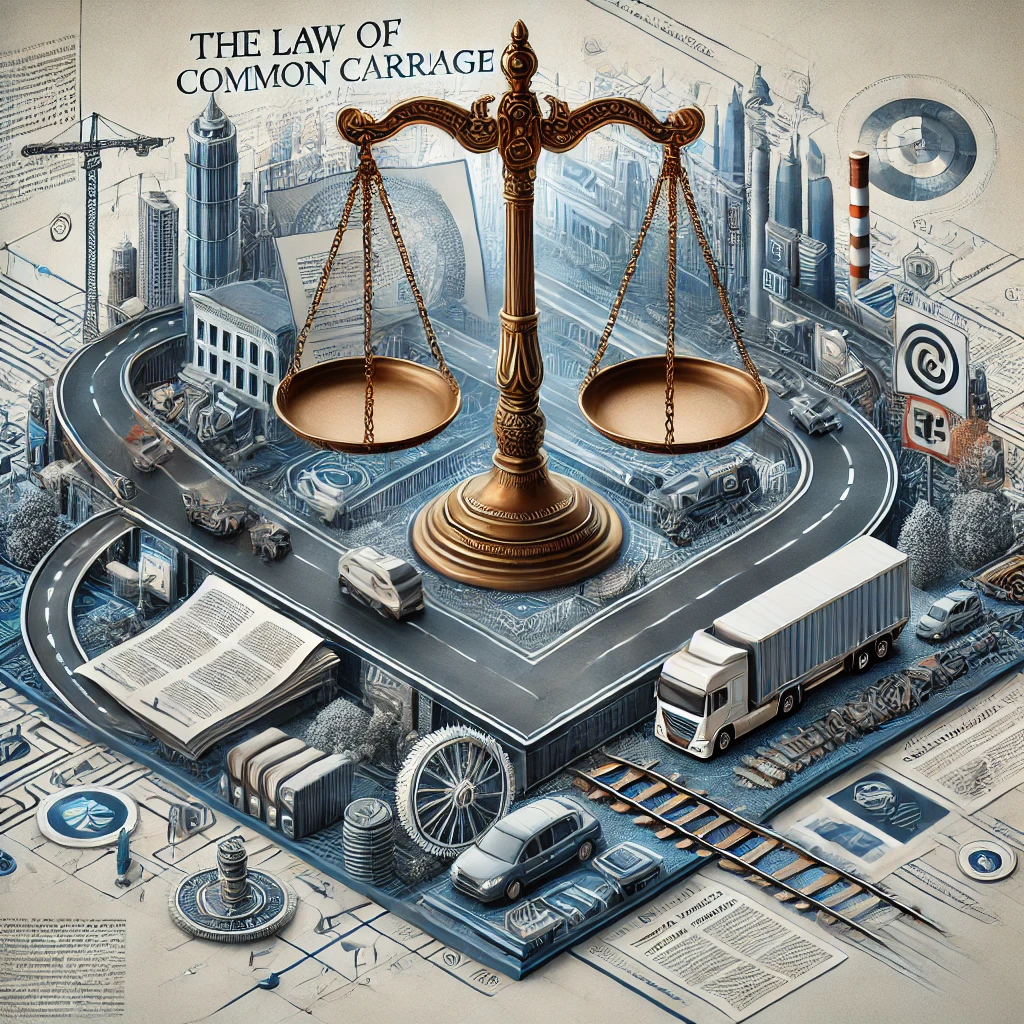Law of Common Carriage: Understanding Common Carrier Laws and Regulations

Key Takeaways:
- The law of common carriage governs the legal obligations of common carriers
- Common carrier laws ensure fair, non-discriminatory service to the public
- Regulations cover areas such as liability, duty of care, and insurance requirements
- Laws vary by jurisdiction and type of common carrier
- Recent legal cases and technological advancements are shaping the future of common carrier law
Historical Development of Common Carrier Legislation
The concept of common carriage has deep historical roots:
- Roman Law: The earliest principles of common carriage can be traced back to Roman law, which recognized special obligations for public service providers.
- Medieval English Common Law: The concept evolved in medieval England, where certain professions were deemed “common callings” with specific duties to the public.
- 17th and 18th Centuries: English courts further developed the law of common carriage, establishing principles of liability and non-discrimination.
- 19th Century Industrial Revolution: With the advent of railroads, common carrier law expanded significantly to address new forms of transportation.
- 20th Century Developments: The law adapted to include new technologies like automobiles, airplanes, and telecommunications.
- 21st Century Challenges: Current debates focus on applying common carrier principles to internet service providers and digital platforms.
This historical progression demonstrates how the law of common carriage Definition and Basics of Common Carriers has continuously evolved to address changing technologies and societal needs.
Key Laws Governing Common Carriers in Different Jurisdictions
Common carrier laws vary by jurisdiction and type of carrier. Here are some key examples:
- United States:
- Interstate Commerce Act (1887)
- Communications Act (1934)
- Airline Deregulation Act (1978)
- Motor Carrier Act (1980)
- Telecommunications Act (1996)
- European Union:
- Regulation (EC) No 1071/2009 (Road Transport Operators)
- Regulation (EC) No 1072/2009 (International Road Haulage)
- Directive 2012/34/EU (Single European Railway Area)
- United Kingdom:
- Railways and Transport Safety Act 2003
- Communications Act 2003
- Canada:
- Canada Transportation Act
- Telecommunications Act
- Australia:
- Competition and Consumer Act 2010
- Telecommunications Act 1997
These laws establish the framework for Definition and Basics of Common Carriers common carrier operations, liability, and regulatory oversight in their respective jurisdictions.
Common Carrier Duty of Care: Legal Obligations and Responsibilities
A fundamental aspect of the law of common carriage is the duty of care imposed on common carriers:
- High Standard of Care: Common carriers are generally held to a higher standard of care than ordinary businesses.
- Non-Discrimination: They must serve all customers without unreasonable discrimination.
- Safety Obligations: Carriers have a duty to ensure the safety of passengers and integrity of goods.
- Timely Service: There’s an obligation to provide service within a reasonable timeframe.
- Proper Handling of Goods: Carriers must handle goods with appropriate care and skill.
- Adherence to Routes and Schedules: They must generally stick to published routes and schedules.
- Transparency in Pricing: Many jurisdictions require clear and public pricing structures.
These obligations form the core of a common carrier’s legal responsibilities under the law of common carriage.
Liability and Insurance Requirements for Common Carriers
Liability is a crucial aspect of common carrier law:
- Strict Liability: In many jurisdictions, common carriers are held to a standard of strict liability for loss or damage of goods.
- Limitations on Liability: Laws often allow carriers to limit their liability to a certain amount, provided they follow specific procedures.
- Insurance Requirements: Common carriers are typically required to maintain certain levels of insurance coverage:
- General Liability Insurance
- Cargo Insurance
- Auto Liability Insurance (for motor carriers)
- Workers’ Compensation Insurance
- Liability for Delays: In some cases, carriers may be liable for financial losses due to delays.
- Force Majeure Exceptions: Carriers may be excused from liability in cases of “acts of God” or other unforeseeable circumstances.
- Contractual Limitations: The extent to which carriers can limit liability through contracts varies by jurisdiction.
Understanding these liability and insurance requirements is crucial for both carriers and shippers operating under the law of common carriage.

Regulatory Bodies Overseeing Common Carriers
Various government agencies are responsible for enforcing common carrier laws:
- United States:
- Federal Motor Carrier Safety Administration (FMCSA)
- Federal Aviation Administration (FAA)
- Federal Maritime Commission (FMC)
- Federal Communications Commission (FCC)
- European Union:
- European Railway Agency (ERA)
- European Maritime Safety Agency (EMSA)
- Body of European Regulators for Electronic Communications (BEREC)
- United Kingdom:
- Office of Rail and Road (ORR)
- Civil Aviation Authority (CAA)
- Office of Communications (Ofcom)
- Canada:
- Canadian Transportation Agency
- Canadian Radio-television and Telecommunications Commission (CRTC)
- Australia:
- Australian Communications and Media Authority (ACMA)
- Civil Aviation Safety Authority (CASA)
These regulatory bodies play a crucial role in interpreting and enforcing the law of common carriage.
Compliance Challenges for Common Carriers
Adhering to common carrier laws presents several challenges:
- Keeping Up with Regulatory Changes: Laws and regulations frequently evolve, requiring constant vigilance.
- Jurisdictional Variations: Carriers operating across borders must navigate different legal requirements.
- Technology Integration: Implementing new technologies while ensuring compliance can be complex.
- Balancing Service and Compliance: Meeting regulatory requirements while maintaining efficient operations.
- Data Protection and Privacy: Especially relevant for telecommunications carriers.
- Environmental Regulations: Increasingly stringent environmental laws affect many common carriers.
- Safety Compliance: Adhering to evolving safety standards and regulations.
Addressing these challenges is crucial for common carriers to operate legally and efficiently under the law of common carriage.

Consumer Rights and Protections Under Common Carrier Laws
The law of common carriage provides several protections for consumers:
- Right to Service: Common carriers generally cannot refuse service without just cause.
- Non-Discrimination: Consumers are protected against unfair discrimination in service provision.
- Transparent Pricing: Many jurisdictions require clear and public rate structures.
- Safety Standards: Consumers benefit from mandated safety standards for carriers.
- Complaint Mechanisms: Regulatory bodies often provide avenues for consumer complaints.
- Compensation for Losses: Laws typically provide for compensation in cases of loss, damage, or delay.
- Privacy Protections: Particularly relevant for telecommunications carriers.
These consumer protections are a key aspect of common carrier law, ensuring fair and reliable service for the public.
Recent Legal Cases and Their Impact on Common Carrier Regulations
Several recent legal cases have shaped the interpretation and application of common carrier laws:
- FCC v. AT&T Inc. (2011): U.S. Supreme Court case affecting interpretation of personal privacy under communications laws.
- ABC Transportes S.A. v. CMR (2018): European Court of Justice case clarifying liability limits under the CMR Convention.
- United States v. American Airlines, Inc. (2019): Case involving enforcement of consumer protection regulations in the airline industry.
- Mozilla Corp. v. FCC (2019): D.C. Circuit Court case regarding net neutrality and classification of internet service providers as common carriers.
- AirHelp Ltd v. Scandinavian Airlines System Denmark-Norway-Sweden (2020): European Court of Justice case on air passenger rights during extraordinary circumstances.
These cases demonstrate how the Definition and Basics of Common Carriers law of common carriage continues to evolve through judicial interpretation.

International Laws and Agreements Affecting Common Carriers
Common carriers operating internationally must navigate a complex web of laws and agreements:
- Convention on the Contract for the International Carriage of Goods by Road (CMR): Governs international road transport in Europe.
- Montreal Convention: Establishes rules for international air carriage.
- Hague-Visby Rules: International rules governing maritime shipping contracts.
- COTIF-CIM: Convention concerning International Carriage by Rail.
- IATA Resolutions: While not laws, these influence international air transport practices.
- Bilateral Air Service Agreements: Govern international air services between countries.
- WTO’s General Agreement on Trade in Services (GATS): Affects international trade in transport services.
Understanding these international frameworks is crucial for common carriers operating across borders.
Future of Common Carrier Legislation and Potential Reforms

The law of common carriage continues to evolve:
- Digital Platforms: Debates about applying common carrier principles to social media and search engines.
- Autonomous Vehicles: Potential new regulations for self-driving cars and trucks.
- Drone Delivery: Emerging laws to govern drone-based delivery services.
- Space Transportation: As commercial space travel develops, new common carrier laws may be needed.
- Data as Transport: Discussions about treating data transmission more explicitly under common carrier law.
- Environmental Regulations: Increasing focus on sustainability in transport regulations.
- Cybersecurity Requirements: Growing emphasis on protecting against digital threats.
These potential reforms highlight the dynamic nature of common carrier law and its ongoing adaptation to technological and societal changes.
Conclusion: The Evolving Landscape of Common Carrier Law
The law of common carriage has been a cornerstone of transportation and communication regulation for centuries. From its roots in Roman and English common law to its application to modern technologies, it has consistently evolved to meet the changing needs of society and commerce.
Today, as we stand on the brink of new technological revolutions – from autonomous vehicles to commercial space travel – the principles of common carrier law continue to be debated and applied in new contexts. The fundamental goals of ensuring fair, non-discriminatory service, maintaining safety standards, and protecting consumer rights remain as relevant as ever.
For businesses operating as common carriers, understanding and complying with these laws is crucial. For consumers, knowledge of these regulations empowers them to assert their rights and make informed choices. And for policymakers and legal professionals, the ongoing evolution of common carrier law presents both challenges and opportunities to shape the future of transportation and communication services.
As we move forward, the law of common carriage will undoubtedly continue to adapt, balancing the need for regulation with the drive for innovation. By understanding its history, current applications, and potential future directions, we can better navigate the complex landscape of common carrier operations in our increasingly connected world.
